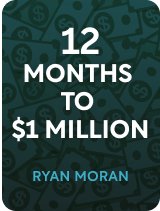

This article is an excerpt from the Shortform book guide to "12 Months to $1 Million" by Ryan Daniel Moran. Shortform has the world's best summaries and analyses of books you should be reading.
Like this article? Sign up for a free trial here.
Are you launching a new product soon? How can you guarantee that your product will continue to sell out?
Once you’ve launched your first product and are taking sales, 12 Months to $1 Million by Ryan Moran writes that your focus should be on growing your sales. Moran explains how you can achieve 25 sales per day by effectively maintaining your inventory and creating positive buzz.
Discover how to grow sales in business and keep the momentum going.
1. Maintain Your Inventory and Funding
The first tip for how to grow sales in business is to manage your inventory and keep your product in stock. Running out of your product can be disastrous for your business: It prevents you from making revenue, destroys your sales momentum, and loses customer engagement. Managing your inventory can be tricky, however, because you have to anticipate the demand for your product. If your product gains sudden popularity and your sales volume spikes, you might run out of stock and be unable to fulfill all the orders.
One main challenge to keeping your product in stock is having enough money to order it. Moran recommends you have $10,000 available at your disposal at all times for this purpose.
If you don’t have that kind of money, there are some other options you can consider to fund your business:
Option #1: Find an investor. Bringing in an outside investor can be one of the quickest ways to get money, Moran writes. To give a successful pitch to an investor, Moran suggests you ask them for advice, not money: First, tell them how well your product is selling and how you plan to continue growing your business. Then, ask how they would fund your business if they were you. Asking for advice opens people to helping you, while asking for money closes them up.
Option #2: Run a crowdfunding campaign. You can get regular people to support your business through crowdfunding sites like Kickstarter. To create a compelling campaign, Moran suggests you create a video showcasing your product, your goals, and your plans for the future.
Option #3: Borrow money. Another way to fund your business is to get a loan. But, this option has some drawbacks: It can take a long time to get approved and you’ll have to pay it back with interest. Moran recommends you borrow money only when you know you’ll make money by using it—for example, when you’re sure you can sell all of your inventory and make a profit. Don’t borrow money for things that have no guaranteed profit. For example, don’t take on debt for advertising, because you don’t know how much money ads will bring in.
Once you’ve figured out how to pay for your inventory, consider Moran’s tips for avoiding a stockout:
Tip #1. Don’t wait to restock your inventory. Reorder as soon as you know your product has some demand. This should be right as your launch ends or when you start getting more than 10 sales daily.
Tip #2: Increase your product price. If your product is selling faster than you can restock your inventory, Moran recommends raising the price of your product to slow the rate of sales.
Tip #3: Place big inventory orders. Ordering your products in bulk not only allows you to avoid the risk of stockouts, but it also gives you more room to negotiate discounts with your supplier.
2. Get Positive Reviews
Maintaining your inventory helps you sustain your sales, but how do you increase your sales to 25 per day? According to Moran, the best way to do this is to get more positive reviews, which you can do by engaging with your customers—the real force behind your sales. This means responding to comments and reviews, getting testimonials, and continuing to share the growth of your business. Being active with your audience helps you grow a sense of community, trust, and loyalty, while also increasing awareness about your product.
(Shortform note: While Moran suggests you increase your sales by continuing to interact with your audience, some marketing experts argue that you should focus on attracting new customers rather than nurturing connections with existing customers. In How Brands Grow, Byron Sharp states that marketing aimed at existing customers isn’t very effective because they’ll never buy more than what they want or need. Instead, Sharp suggests you try to expand your audience.)
To get more positive reviews, Moran suggests you ask for feedback from your customers and then reward them for giving it. For example, you might ask how they like the product, give them a discount code when they reply, and then ask them to leave a review on the product.
(Shortform note: In Building a StoryBrand, Donald Miller suggests you specifically get testimonials that showcase how your product changed your customers’ lives. To do this, ask your customers questions such as what problem they faced before encountering your product, how it felt dealing with that problem, how your product resolved this problem, and how their life has since changed. Miller writes that testimonials describing transformation are effective because people are most motivated by the opportunity for transformation—to feel like they’ve become more adventurous, creative, or attractive, for instance.)
Once you receive good feedback or reviews, Moran suggests you screenshot them and share them on social media. This shows your audience that you care about their opinions and also displays their satisfaction with your product.
(Shortform note: In Contagious, Jonah Berger agrees with Moran’s suggestion to share feedback from satisfied customers. He argues that price, quality, and advertising are less important contributors to a product’s popularity than word of mouth. Beyond screenshotting and sharing positive feedback to create public visibility, you can also make your product advertise itself by displaying your product name or logo on your product. You can also give a free gift to customers that have your brand on it. This way, people are immediately aware of your brand when they see others using your product.)

———End of Preview———
Like what you just read? Read the rest of the world's best book summary and analysis of Ryan Daniel Moran's "12 Months to $1 Million" at Shortform.
Here's what you'll find in our full 12 Months to $1 Million summary:
- Why it's not only possible, but simple, to build a $1 million business in a year
- Proven techniques for creating breakthrough products
- How to decide whether to scale or sell your business






